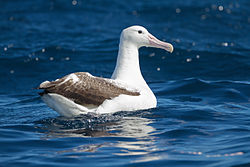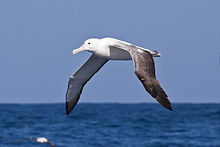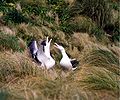- Southern Royal Albatross
-
Southern Royal Albatross 
East of Tasmania Conservation status Scientific classification Kingdom: Animalia Phylum: Chordata Class: Aves Order: Procellariiformes Family: Diomedeidae Genus: Diomedea Species: D. epomophora Binomial name Diomedea epomophora
(Lesson, 1785)[2]Synonyms Diomedea epomophora epomophora
The Southern Royal Albatross, Diomedea epomophora, is a large seabird from the albatross family. At an average wingspan of around 3 m (9.8 ft), it is the second largest albatross, behind the Wandering Albatross.
Contents
Taxonomy
Albatrosses belong to Diomedeidae family and come from the Procellariiformes order, along with Shearwaters, Fulmars, Storm-petrels, and Diving-petrels. They share certain identifying features. First, they have nasal passages that attach to the upper bill called naricorns; the nostrils of the Albatross are on the sides of the bill. The bills of Procellariiformes are also unique in that they are split into between 7 and 9 horny plates. Finally, they produce a stomach oil made up of wax esters and triglycerides that is stored in the proventriculus. This is used against predators as well as an energy rich food source for chicks and for the adults during their long flights.[3] It was once considered conspecific with the Northern Royal Albatross (Diomedea sanfordi) as the Royal Albatross and the split into two species is almost universally accepted. BirdLife International,[4] Brooke,[5] and Robertson & Nunn.[6] Clements still does not recognize the split,[7] and the SACC has recognized the need for a proposal.[8]
Etymology
Diomedea antipodensis breaks into Diomedea referring to Diomedes, whose companions turned to birds.[9]
Description
The Southern Royal Albatross has a length of 112–123 cm (44–48 in)[10] and a mean weight of 8.5 kg (19 lb). Males are about 2 to 3 kg (4.4 to 6.6 lb) heavier than females. Average wingspan has been reported from 2.9 to 3.28 m (9.5 to 10.8 ft), with an upper limit of about 3.51 m (11.5 ft). The Wandering albatross can exceed this species in maximum size and averages slightly larger, but the two species are close enough in dimensions that size cannot be used to distinguish between them.[11][12][13] The juvenile has a white head, neck, upper mantle, rump, and underparts. There are black speckles on the mantle, and they have dark brown or black wings with white flecks on coverts. Their tail is white except for the black tip as is the under-wing. As they age the back, wings, and tail. All ages have a pink bill with black on the cutting edge on the upper mandible, and the legs are flesh. They are hard to differentiate from the Northern Royal Albatross and the Wandering Albatross, with the Southern having white on the upper wing. The average life span is 42.3 years.[10]
Range
Breeding Population and Trends[10] Location Population Date Trend Campbell Islands 8,200-8,600 pair 1997 Stable Enderby Island 69 pair 2001 Stable Auckland Island & Adams Island 20 pair 2001 Stable Total 28,000-29,500 1997 Stable The majority of the world's population of Southern Royal Albatrosses nest on the rat free Sub-antarctic Campbell Island, around 8,200 to 8,600 pairs. There are smaller colonies on Adams Island and Auckland Island in the Auckland Islands,20 pairs combined, and 69 pairs on Enderby Island and some sanfordi X epomophora hybrids at the Northern Royal Albatross colony on the Otago Peninsula in New Zealand. They range along the southern oceans concentrating on the west and east coast of southern South America, and also in the waters surrounding New Zealand.[10]
Behavior
Feeding
The Southern Royal Albatross eats squid and fish, with smaller amounts of carrion, crustaceans, and salps.[10]
Reproduction
They prefer to nest on tussock grassland, plateaus, or ridges, and will lay one egg biennially. Both parents will incubate the egg, and rear the young. When feeding the young they will range south to the Campbell Plateau and north to the Chatham Rise.[10]
Conservation
The IUCN classifies this bird as Vulnerable,[1] with an occurrence range of 63,400,000 km2 (24,500,000 sq mi), and a breeding range of 750 km2 (290 sq mi) with a total estimated population of between 28,000 and 29,500 (1997).
The population is recovering from its severe downward spiral in the late 19th century and the early 20th century. By the 1880s, this Albatross was extirpated from Auckland Island and Enderby Island. Pigs and cats are still a problem, as they take chicks and eggs, on Auckland Island. Longline fishing is a major problem and a possible emerging threat in Dracophyllum, a scrub that is taking away from their nesting range.[10]
Gallery
-
Southern Royal Albatross off Kaikoura, New Zealand
Footnotes
- ^ a b BirdLife International (2008)
- ^ Brands, S. (2008)
- ^ Double, M. C. (2003)
- ^ Lee, James (2008)
- ^ Brooke, R. (2004)
- ^ Robertson, C. J. R. & Nunn, G. B. (1998)
- ^ Clements, J. (2007)
- ^ Remsen Jr., C. J. (2008)
- ^ Gotch, A. F. (1995)
- ^ a b c d e f g BirdLife International (2008)(a)
- ^ Brooke, Michael, Albatrosses and Petrels across the World. Oxford University Press (2004), ISBN 978-0198501251
- ^ Wood, Gerald (1983). The Guinness Book of Animal Facts and Feats. ISBN 978-0-85112-235-9.
- ^ Harrison, Peter, Seabirds: An Identification Guide. Houghton Mifflin Harcourt (1991), ISBN 978-0395602911
References
- BirdLife International (2008). Diomedea epomophora. In: IUCN 2008. IUCN Red List of Threatened Species. Downloaded on 18 Feb 2009.
- BirdLife International (2008(a)). "Bartlett's Tinamou - BirdLife Species Factsheet". Data Zone. http://www.birdlife.org/datazone/species/index.html?action=SpcHTMDetails.asp&sid=38&m=0. Retrieved 18 Feb 2009.
- Brands, Sheila (Aug 14 2008). "Systema Naturae 2000 / Classification - Diomedea (Diomedea) epomophora -". Project: The Taxonomicon. http://www.taxonomy.nl/Main/Classification/51479.htm. Retrieved 18 Feb 2009.
- Brooke, M. (2004) "Procellariidae" Albatrosses And Petrels Across The World Oxford, UK: Oxford University Press ISBN 0-19-850125-0
- Clements, James (2007). The Clements Checklist of the Birds of the World (6 ed.). Ithaca, NY: Cornell University Press. ISBN 978 0 8014 4501 9.
- Double, M. C. (2003). "Procellariiformes (Tubenosed Seabirds)". In Hutchins, Michael; Jackson, Jerome A.; Bock, Walter J. et al.. Grzimek's Animal Life Encyclopedia. 8 Birds I Tinamous and Ratites to Hoatzins. Joseph E. Trumpey, Chief Scientific Illustrator (2 ed.). Farmington Hills, MI: Gale Group. pp. 107–111. ISBN 0 7876 5784 0.
- Gotch, A. F. (1995) [1979]. "Albatrosses, Fulmars, Shearwaters, and Petrels". Latin Names Explained A Guide to the Scientific Classifications of Reptiles, Birds & Mammals. New York, NY: Facts on File. p. 190. ISBN 0 8160 3377 3.
- Lee, James (06 Oct 2008(b)). "Table 7: Species changing IUCN Red List Status" (PDF). IUCN RedList. BirdLife International. http://www.iucnredlist.org/documents/2008RL_stats_table_7_v1223294385.pdf. Retrieved 18 Feb 2009.[dead link]
- Remsen Jr., J. V.; et al. (07 Aug 2008). "A classification of the bird species of South America, South American Classification Committee, American Ornithologists' Union". South American Classification Committee. American Ornithologists' Union. http://www.museum.lsu.edu/~Remsen/SACCBaseline.html. Retrieved 18 Feb 2009.
- Robertson, C. J. R.; Nunn, G. B. (1998) "Towards a new taxonomy of albatrosses" Albatross Biology and Conservation Chipping Norton, Australia: Surrey Beatty & Sons Ltd. pp. 13–19
External links
Categories:- IUCN Red List vulnerable species
- Albatrosses
- Birds of New Zealand
- Birds of Western Australia
- Birds of Africa
- Birds of South Africa
- Vulnerable fauna of Australia
- Fauna of Campbell Island, New Zealand
- Animals described in 1785
Wikimedia Foundation. 2010.







